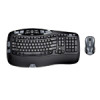Logitech Desktop Wave Making of Wave - Page 5
The Most Innovative Design Is the Right Choice - desktop waves
 |
View all Logitech Desktop Wave manuals
Add to My Manuals
Save this manual to your list of manuals |
Page 5 highlights
Creating Comfort: The Making of the Logitech Comfort Wave Design - Page 5 Early on in the industrial-design development process, Senior Designer Cathal Lougnane of Design Partners accompanied one of his fellow designers to get his Land Rover serviced at a dealership. Sitting inside one of the car models, Loughnane had an epiphany. He saw that an organic, curved shape could convey a powerful sense of performance and also provide exceptional comfort. He realized that, in contrast to the hard lines and angles of the diNovo Edge, whatever the final look the Wave keyboard would take, it should use a different design language - one with natural forms: rounded edges and smooth transitions. With the design ID established, Design Partners began developing models. Linear designs. Curved designs. Keyboards with a wave-shaped key frame and a curved layout. A keyboard with only a wave key frame. A keyboard with only a curved layout. Keyboards with and without a palm rest. Different shapes - every one trying to speak the specific design language of comfort and performance. In May 2006, Design Partners presented several models to Logitech's Desktop development team, including product marketing and engineering. When everyone gathered around the conference table in Logitech's offices in Switzerland, the response from the Logitech team was immediate and overwhelming. Remember, Logitech was concerned that the majority of people would be scared away by a design that deviated too far from the norm. They wanted to try any element - a wave, a curve, a palm rest - that would add comfort. But they didn't want to intimidate people, either. Maybe all three together would be too much. To everyone's delight, when they brought all the models in one room, and put their fingers on the keys, it was the most comprehensive approach - the keyboard with the wave-shaped key frame, the curved layout and the palm rest - that was the clear favorite. Everyone agreed: the keyboard with all three elements would provide the most comfort. But would people embrace it? The product marketing team discussed taking a cautious approach. Perhaps, they reasoned, it might be wise to shelve the idea of incorporating more than just a wave; they felt that they could introduce the curve and the palm rest later. The team had now been working on the project for nearly a year. It was time to get an unbiased opinion. The next step was to take their models to the people and see what they thought. The Most Innovative Design Is the Right Choice In June 2006, Logitech presented a series of models to focus groups in California, France and Germany. Participants were presented with straight keyboards, curved keyboards, wave keyboards, straight-with-a-wave keyboards, and curve + wave + palm rest keyboards. Traditionally, the combined results of a focus group favor designs that fall in the middle of a range. In this case, the middle of the range was the wave and curved keyboards.










